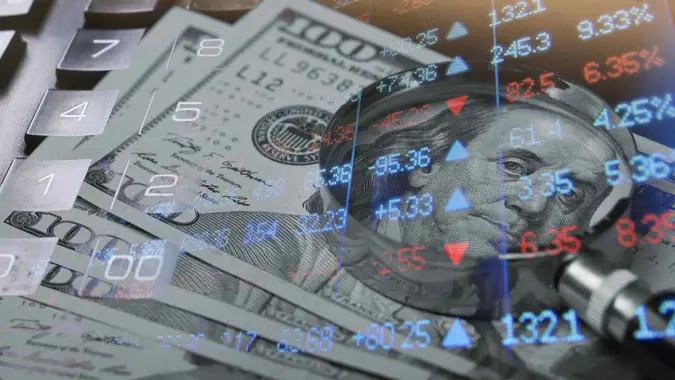Gold vs Silver Investment: Which is the Better Choice?

Commitment to Our Readers
GOBankingRates' editorial team is committed to bringing you unbiased reviews and information. We use data-driven methodologies to evaluate financial products and services - our reviews and ratings are not influenced by advertisers. You can read more about our editorial guidelines and our products and services review methodology.

20 Years
Helping You Live Richer

Reviewed
by Experts

Trusted by
Millions of Readers
Investing in precious metals has always been a go-to strategy for those looking to diversify their portfolios and hedge against economic uncertainty. But when it comes to gold vs silver investment, which metal offers better returns and long-term stability? Both have their advantages and drawbacks, so understanding their unique characteristics is key to making an informed investment decision.
In this guide, we’ll break down the pros and cons of investing in gold and silver, compare them side by side and help you decide which option aligns best with your financial goals.
Key Differences Between Gold and Silver
Before diving into the benefits and risks of each metal, let’s look at some core differences between gold and silver that could influence your investment choice.
Value and Price
- Gold: Known for its higher price point, gold is often seen as a symbol of wealth and stability. It’s more expensive per ounce and is less affected by industrial demand, making it a traditional “safe haven” during economic downturns.
- Silver: Silver is more affordable and accessible, especially for first-time investors. However, it’s more volatile in price due to its significant industrial applications.
Supply and Demand
- Gold: Global demand for gold comes largely from jewelry and investment purposes. Its supply is relatively stable, with mining and recycling accounting for most of the availability.
- Silver: Silver’s demand is influenced not only by jewelry and investment but also by industrial uses, like electronics and solar panels, making its price more sensitive to economic changes.
Benefits of Investing in Gold
Gold has long been a favored choice for investors seeking stability and long-term value. Here are some top reasons why gold might be a smart addition to your portfolio.
- Inflation Hedge: Gold is known to retain its value during periods of high inflation. When the value of currency decreases, gold prices typically rise.
- Global Demand: Gold is universally recognized, making it easy to buy, sell and trade worldwide.
- Stability During Economic Downturns: When markets become volatile, gold often acts as a safe haven, maintaining its value and offering protection against economic uncertainty.
- Liquidity: Gold is easy to convert into cash, ensuring flexibility if you need to access funds quickly.
Benefits of Investing in Silver
Silver also has its strengths, particularly for those looking for an accessible and potentially high-growth investment.
- Affordability: Silver’s lower price makes it easier for beginners to enter the market or for experienced investors to diversify their holdings.
- Industrial Demand: Silver is essential in industries like electronics, solar energy and medical equipment. As these sectors grow, so does silver’s value potential.
- Price Volatility: While riskier, silver’s volatility can lead to higher gains during market upswings.
- Portfolio Diversification: Investing in silver alongside other assets helps balance risk and increase overall portfolio resilience.
Risks of Investing in Gold
While gold offers many benefits, it’s not without its risks. Here are a few considerations to keep in mind:
- Price Stability Can Limit Growth: Gold’s stability is a double-edged sword. While it protects against losses, it can also mean slower growth compared to other investment types.
- Higher Entry Costs: Gold is more expensive per ounce, requiring a larger initial investment.
- Market Fluctuations: Though stable, gold prices still fluctuate based on geopolitical and economic events.
Risks of Investing in Silver
Silver, though accessible, carries its own set of challenges that investors should understand:
- Volatility: Silver prices are more volatile than gold, often reacting strongly to economic shifts.
- Storage and Space: Because it’s less valuable per ounce, storing significant amounts of silver requires more space.
- Market Sensitivity: Silver’s heavy reliance on industrial demand makes its price more vulnerable to market changes and economic cycles.
How to Invest in Gold and Silver
If you’re considering adding gold or silver to your portfolio, it’s helpful to know the common investment options available for each metal.
Gold Investment Options
- Physical Gold: Buy gold bars, coins or jewelry. It’s tangible and gives you direct ownership.
- Gold ETFs: Exchange-traded funds offer exposure to gold prices without the need to store physical assets.
- Gold Mining Stocks: Investing in companies that mine gold can provide growth potential, though it comes with stock market risks.
- Mutual Funds: Some mutual funds focus on precious metals, offering diversified exposure.
Silver Investment Options
- Physical Silver: Like gold, you can purchase silver in coins, bars, or jewelry for direct ownership.
- Silver ETFs: These funds offer an easy way to invest in silver without handling physical assets.
- Silver Mining Stocks: Investing in companies focused on silver production can offer high returns but comes with market risks.
- Mutual Funds: Look for funds that include silver or other precious metals as part of their portfolio.
Gold vs Silver: Which is the Better Investment for You?
Deciding between gold and silver comes down to your investment goals and risk tolerance.
- For Stability: If you prefer a lower-risk investment that retains value over time, gold might be the better choice.
- For Potential Growth: If you’re comfortable with more risk in exchange for potentially higher returns, silver could offer exciting opportunities.
- For Diversification: A mix of both gold and silver can balance risk while maximizing potential gains.
Comparison Table: Gold vs Silver Investment
| Factor | Gold | Silver |
|---|---|---|
| Price | Higher, more stable | Lower, more volatile |
| Industrial Use | Limited | Extensive (electronics, energy) |
| Volatility | Less volatile | More volatile |
| Affordability | Higher entry cost | More affordable for new investors |
| Storage | Requires less space | Needs more storage for the same value |
Final Take to GO
Choosing between gold and silver as an investment isn’t about finding a “better” option — it’s about finding the right fit for your financial goals. Gold offers stability and acts as a reliable hedge against economic uncertainty, while silver is more affordable and presents greater potential for higher returns.
If you’re just starting or seeking to diversify your portfolio, consider investing in both. This approach allows you to balance the safety of gold with the growth potential of silver, creating a well-rounded investment strategy.
Ready to start investing? Take the next step and explore your options today!
FAQs About Gold vs Silver Investment
Here are the answers to some of the most frequently asked questions about investing in gold vs. silver:- Which is a safer investment, gold or silver?
- Gold is generally considered safer due to its long history of stability and value retention. Silver carries more price volatility but offers higher short-term growth potential.
- Can I make money faster with silver than with gold?
- Potentially, yes. Silver’s price can experience sharper gains during market upswings. However, it also carries more risk during downturns.
- How do I buy gold or silver for investment?
- You can purchase physical gold or silver from reputable dealers, invest in ETFs or consider stocks and mutual funds related to precious metals.
- Is it better to invest in gold or silver during economic downturns?
- Gold is often preferred during downturns due to its stability. However, silver can also be a good option if industrial demand remains strong.
Information is accurate as of March 14, 2025.
Editorial Note: This content is not provided by any entity covered in this article. Any opinions, analyses, reviews, ratings or recommendations expressed in this article are those of the author alone and have not been reviewed, approved or otherwise endorsed by any entity named in this article.
Editor's note: This article was produced via automated technology and then fine-tuned and verified for accuracy by a member of GOBankingRates' editorial team.
Our in-house research team and on-site financial experts work together to create content that’s accurate, impartial, and up to date. We fact-check every single statistic, quote and fact using trusted primary resources to make sure the information we provide is correct. You can learn more about GOBankingRates’ processes and standards in our editorial policy.
- Google Finance "Gold price"
- Google Finance "Silver price"
- Reuters "Gold scales record high, sprints towards $3,000 milestone"
- USGS "Silver Statistics and Information"
- The New York Times "Gold Hits Record High Amid Tariff Anxiety"
- ETF Database "Gold ETFs"
- ETF Database "Silver ETFs"
 Written by
Written by  Edited by
Edited by 

























